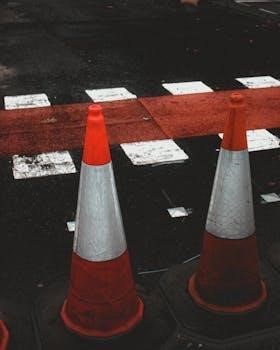Cross stitch is a timeless craft, perfect for creating beautiful designs․ It involves making X-shaped stitches on fabric․ This guide introduces the basics, ideal for beginners․ Learn essential techniques and tips to start your cross stitch journey․ Discover how to create stunning patterns using simple stitches and readily available materials․
Cross stitch, a form of counted thread embroidery, offers a delightful way to create intricate designs with simple X-shaped stitches; This accessible craft is perfect for beginners eager to explore the world of needlework․ Its ease of learning makes it an ideal starting point for anyone interested in embroidery, allowing you to quickly grasp the fundamentals and begin crafting beautiful pieces․ Cross stitch can be used to embellish garments, create stunning interior decorations, or personalize gifts with a handmade touch․
This guide provides a comprehensive introduction to cross stitch, breaking down the process into easy-to-follow steps․ You’ll learn about the essential materials required, including Aida cloth, embroidery floss, needles, and scissors․ We’ll also cover basic techniques such as starting a stitch, the English method, the Danish method, and securing the thread․ With clear instructions and helpful tips, you’ll gain the skills and knowledge needed to embark on your first cross stitch project with confidence․
Whether you’re a complete novice or have some experience with embroidery, this introduction will equip you with the necessary tools and techniques to create stunning cross stitch designs․ Embrace the relaxing and rewarding nature of cross stitch and discover the joy of transforming simple stitches into intricate works of art․ Let’s begin this creative adventure together!

Essential Materials for Beginners
To begin your cross stitch journey, gather essential materials․ You’ll need Aida cloth, the foundation for your stitches․ Embroidery floss, available in various colors, brings your design to life․ Needles and scissors are crucial for precise stitching and trimming․ These basics ensure a successful start․
Aida Cloth
Aida cloth is the most popular fabric choice for cross stitch, especially among beginners․ Its even weave and distinct square pattern make it easy to count stitches and create uniform designs․ The fabric is typically made of cotton and is characterized by small holes that guide the needle, ensuring consistent stitch placement․
Aida cloth is available in various counts, referring to the number of stitches per inch․ Lower counts, such as 11-count Aida, have larger holes, making them suitable for beginners as they are easier to see and work with․ Higher counts, like 18-count Aida, have smaller holes, resulting in more detailed and intricate designs․
When selecting Aida cloth, consider the project’s size and desired level of detail․ A larger project with fewer details may benefit from a lower count Aida, while a smaller, more intricate design would be better suited for a higher count․
Aida cloth also comes in various colors, allowing you to choose a background that complements your design․ White and cream are classic choices, but you can also find Aida in a wide range of hues to add a unique touch to your project․
Before starting your cross stitch project, it’s recommended to pre-wash the Aida cloth to prevent shrinkage and ensure colorfastness․ This will help maintain the integrity of your finished piece․
Embroidery Floss
Embroidery floss, the colorful thread used to create cross stitch designs, is a crucial element in any cross stitch project․ Typically made of cotton, embroidery floss consists of six individual strands that can be separated to adjust the thickness of the thread, allowing for varying levels of detail and texture in your work․
The most common type of embroidery floss is stranded cotton, known for its soft sheen and wide range of colors․ It’s readily available in a vast spectrum of shades, from vibrant primaries to subtle pastels, offering endless possibilities for creating intricate and colorful designs․
When selecting embroidery floss, it’s essential to choose high-quality brands that are colorfast and resistant to fading․ This will ensure that your finished cross stitch project retains its vibrancy and beauty for years to come․
The number of strands you use will depend on the fabric count and the desired effect․ For Aida cloth with larger holes, using more strands will provide better coverage, while for finer fabrics, fewer strands will create a more delicate look․
Organizing your embroidery floss is crucial for efficient cross stitching․ You can use floss bobbins, thread organizers, or even plastic bags to keep your floss neat and tangle-free․ Labeling each color with its corresponding number will also save time and prevent confusion․
Needles and Scissors
Selecting the right needles and scissors is paramount for a smooth and enjoyable cross stitch experience․ Needles, specifically designed for cross stitch, have rounded points and large eyes to easily accommodate embroidery floss without damaging the fabric․ The size of the needle should correspond to the fabric count; larger needles are suitable for Aida cloth with larger holes, while smaller needles are ideal for finer fabrics․
Tapestry needles are commonly used due to their blunt tip, which allows them to slide easily between the fabric threads without piercing them․ This is crucial for maintaining the integrity of the Aida cloth and creating neat, uniform stitches․
Scissors are equally important for precise thread cutting․ Small, sharp embroidery scissors with pointed blades are perfect for trimming floss ends close to the fabric without accidentally cutting the surrounding stitches․ Investing in a good pair of embroidery scissors will make a significant difference in the quality of your finished work․
Keep your needles organized in a needle case or magnetic strip to prevent them from getting lost or damaged․ Regularly clean your scissors with a soft cloth to remove any thread residue and maintain their sharpness․ Proper care of your needles and scissors will ensure they last for years and contribute to a more enjoyable cross stitch experience;
Consider having multiple needle sizes available to accommodate different fabric counts and thread thicknesses․

Basic Cross Stitch Techniques
Mastering basic techniques is key to successful cross stitch․ Learn essential methods for creating neat and consistent stitches․ Discover the English and Danish methods for efficient stitching․ Understand how to start and secure threads properly․ These techniques form the foundation for intricate designs and projects․
Starting a Stitch
Embarking on a cross stitch project begins with mastering the art of starting your stitch․ This initial step sets the foundation for your entire design, ensuring a clean and secure start․ Avoid knots, as they can create bulk and be difficult to conceal on the back of your work․
A preferred method is the waste knot technique․ Begin by threading your needle and creating a knot at the end of your floss․ Bring the needle up from the front of the fabric a few stitches away from where you intend to begin stitching․ Then, start your cross stitches, ensuring that the stitches you make on the back of the fabric secure the tail of the floss․ Once you’ve stitched over the tail, carefully snip the waste knot from the front․

Another popular approach involves leaving a tail on the back of your work and stitching over it․ Begin by bringing your needle up from the back of the fabric, leaving a tail of about an inch or so․ Hold the tail against the back of the fabric and begin making your cross stitches, ensuring that each stitch secures the tail in place․ After several stitches, the tail will be securely anchored, and you can trim any excess floss․
Regardless of the method you choose, remember to maintain consistent tension to avoid puckering or distortion of the fabric․ A secure and tidy start will contribute to a professional-looking finished piece․
The English Method
The English Method of cross stitch is a technique where each cross is completed individually before moving on to the next․ This approach is favored for its precision and control, making it ideal for intricate patterns with frequent color changes․ To execute the English Method, bring your needle up at the bottom left corner of the stitch․
Next, insert the needle down at the top right corner, completing the first diagonal of the cross․ Then, bring the needle up at the bottom right corner and insert it down at the top left corner, completing the cross․ Each cross is formed individually, ensuring that all the top stitches lie in the same direction for a uniform appearance․ This method is particularly useful when working with variegated floss, as it allows you to control the color placement within each cross․
While the English Method may be slightly slower than other techniques, it offers greater control over stitch placement and tension․ This makes it a suitable choice for beginners who are still developing their stitching skills․ Moreover, the English Method is well-suited for projects with isolated stitches or complex designs where accuracy is paramount․
Remember to maintain consistent tension throughout your stitching to ensure a neat and even finish․ With practice, the English Method can become a reliable and precise technique for creating beautiful cross stitch designs․
The Danish Method
The Danish Method, also known as the Scandinavian Method, is a technique in cross stitch where an entire row of half stitches is completed first, followed by a return pass to complete the crosses․ This method is known for its speed and efficiency, making it a favorite among experienced stitchers․ To begin, work a row of half stitches by bringing the needle up at the bottom left corner of each stitch and inserting it down at the top right corner․
Continue this process until you reach the end of the row; Then, reverse direction and complete the crosses by bringing the needle up at the bottom right corner of each stitch and inserting it down at the top left corner․ This method creates a neat and uniform appearance, as all the top stitches lie in the same direction; The Danish Method is particularly well-suited for large areas of the same color, as it allows you to stitch quickly and efficiently․
However, it is important to maintain consistent tension throughout your stitching to avoid distortion or pulling․ Some stitchers find that the Danish Method can be more challenging to control, especially when working with intricate patterns or color changes․ However, with practice, the Danish Method can become a valuable tool for completing cross stitch projects quickly and efficiently․
It is also important to ensure that the back of your work is neat and tidy, as the Danish Method can sometimes result in longer threads running across the back․ By mastering the Danish Method, you can significantly increase your stitching speed and create beautiful cross stitch designs with ease․
Securing the Thread
Securing your thread at the beginning and end of a cross stitch project is crucial for preventing unraveling and ensuring the longevity of your work; There are several methods for achieving this, each with its own advantages․ One common technique is the waste knot method․ To begin, create a knot at the end of your thread and bring the needle up from the front of the fabric, a few stitches away from your starting point․ As you work your first few stitches, ensure that the thread tail is secured on the back of the fabric․
Once you’ve completed several stitches, carefully cut the knot on the front․ Another popular method is the loop start, particularly useful when working with an even number of strands․ Fold the thread in half, thread the two ends through the needle, and begin stitching, leaving the loop on the back․ Secure the loop by threading the needle through it on the first stitch․
To secure the thread at the end of your stitching, weave the needle through the back of several existing stitches, ensuring that the thread is hidden and secure․ Trim the excess thread close to the fabric․
Avoid making knots at the end of your thread, as they can create bulk and be visible from the front of your work․ Instead, focus on weaving the thread through existing stitches to create a secure and invisible finish․ With careful attention to securing your thread, you can ensure that your cross stitch projects remain beautiful and intact for years to come․

Tips and Tricks for Beginners
Embarking on your cross-stitch journey can be both exciting and a little daunting․ Here are some essential tips and tricks to help beginners create beautiful and satisfying projects․ First, always start with a simple pattern․ Choose a design with a limited number of colors and stitches to build confidence and master the basic techniques before tackling more complex projects․
Good lighting is your best friend․ Ensure you have ample light to clearly see the fabric and floss, reducing eye strain and improving accuracy․ A magnifying lamp can be particularly helpful for intricate details․ Organization is key․ Keep your floss neatly organized using floss bobbins and a storage box to prevent tangling and make it easier to find the colors you need․
Practice makes perfect․ Don’t be discouraged by mistakes․ Every stitch is a learning opportunity․ Consider using a practice piece of Aida cloth to experiment with different techniques before starting your actual project․ Maintain consistent tension in your stitches to achieve a uniform and professional look․ Avoid pulling the thread too tight, as this can distort the fabric․
Finally, don’t be afraid to experiment with different techniques and materials․ Cross stitch is a versatile craft, and there’s always something new to learn and explore․